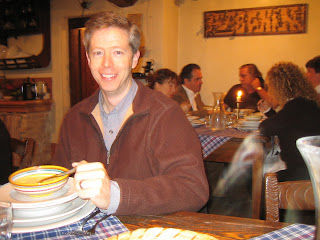 |
| eye-catching fountain in Bologna |
We had a fantastic time in Italy, but that should not surprise anyone who knows how much we like good food! I'll freely admit that we inhaled our first gelato while we were still schlepping our luggage from the airport to our hotel when we arrived in Bologna. In our defense, we had an ambitious itinerary (Bologna, Malvarina, Assisi, Spello, Orvieto, Bologna), so it was important to keep our strength up.
 |
| first things first |
 |
| fresh and gorgeous |
In addition to giving the world baloney (
mortadella), bolognese sauce (
ragù), and tortellini, Bologna has some beautiful sights and interesting history. The oldest university in Europe is here. Who knew??!!
Our first night in Bologna we found a nice little restaurant where I ate a mound of fresh pasta tossed with olive oil and topped with shaved black truffles - simple but simply fabulous! I don't remember what Eric ate. I'm sure it was good, but I was in some sort of truffle-induced stupor and didn't really register his choice.
We left the next day for Malvarina, but we were happy to return to Bologna again at the end of our trip to do more eating and sight seeing. A highlight was the University's Teatro Anatomico, a gorgeous room where medical students and ladies in fancy dresses could observe autopsies. Built in the mid-1600s, a prominent feature of the theater is a throne where an Inquisition priest would sit and be ready to intervene if the proceedings became too spiritually compromising.
 |
| the best seat in the house at the Teatro Anitomico |
Another highlight was the Basilica di San Petronio which was originally designed to be larger than St. Peter's in Rome. Not wanting to see St. Peter's dwarfed, Pope Pius IV blocked construction 169 years after building had started, and the church remains unfinished. Still quite large and impressive, San Petronio houses a HUGE linear calendar which was installed in the floor in 1656. A hole in the roof allows light into the church, and when the sun is at the highest point in the sky, a circle of light falls on the correct date on the calendar. This tool was instrumental in discovering problems with the Julian calendar and led to the creation of the leap year. It was cool and really appealed to our nerdy nature. Let us know if you'd like to borrow the detailed booklet we bought!!
On our last full day in Bologna, we had a food-filled agenda. We started the day with pastries and beverages in a cafe that had once been the stables for the wealthiest, most powerful family in the town ... sight seeing ... heavenly gelato at La Sorbetteria Castiglione ... sight seeing ... lunch at Tamburini, a Bologna landmark ...
 |
| a light lunch at Tamburini |
... sight seeing ... visit to Vecchia Malga Negozi, a deli that was so gorgeous it almost made me cry ...
 |
| a beautiful sight in the Quadrilatero district |
... Italian craft beer and wine at a neat bookstore/bar ... nap ... prosecco and snacks at a bar that had once been the private chapel of the wealthiest, most powerful family in town ... dinner at Osteria de' Poeti which is in the wine cellar of a 14th century palace. Down in the wine cellar, after Eric took one bite of his pumpkin filled tortelloni with butter sauce, I lost him. He did resurface to try the locally made lambrusco wine. Don't laugh - the real stuff is very good!!
 |
| waiting patiently to take his first bite of pasta and sip of lambrusco |
 |
| Neptune casts a manly shadow |
We definitely understand why Bologna is affectionately known as
la grassa (the fat one).
Our next blog entry will be about our days at Malvarina. Beautiful scenery, wonderful people, vigorous exercise, Mama Maria's food...
ciao ~ Peggy





















